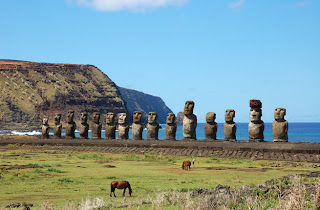 Easter Island (Rapa
Nui in the original language), is a Chilean-governed island in the south eastern Pacific Ocean. Rapa Nui is a little,
hilly now treeless island of
volcanic origin. It is been called the most isolated occupied territory on
Earth, but there is one more aspect that sets it apart from any other place on
Earth its hundreds of megalithic human-like statues that face inland from the
shore. These mysterious statues are
called moai.
Easter Island (Rapa
Nui in the original language), is a Chilean-governed island in the south eastern Pacific Ocean. Rapa Nui is a little,
hilly now treeless island of
volcanic origin. It is been called the most isolated occupied territory on
Earth, but there is one more aspect that sets it apart from any other place on
Earth its hundreds of megalithic human-like statues that face inland from the
shore. These mysterious statues are
called moai.
Almost
all moais were carved out of characteristic, compressed, easily worked volcanic
ash. The biggest one weights up to 165 tons & its height is almost 22
meters. Some upright moai have become covered up to their necks by shifting
soils. This huge production of
megalithic works on an Easter Island that is absolutely barren, with
just grass, right away captures our imagination.
Some
scientists suggest that Easter Island population,
the Rapanui came from Polynesia. However similarities to Indian stone statues
around Lake Titicaca in South America are striking.
Scholars are incapable to definitively explain the function and use of the moai statues. A few of them suggest that the statues were symbols of authority & power, both religious and political.
Scholars are incapable to definitively explain the function and use of the moai statues. A few of them suggest that the statues were symbols of authority & power, both religious and political.
One
of the largest riddles about Easter
Island is how the statues 'traveled' from the quarry to their platforms, every
so often as far as 20 or 25 kilometers away. Rapa Nui legend has it that the
moai ‘walked from the quarry’. However, not more than one third of all embossed
moai actually made it to a final formal ahus site. Was this due to the inherent
difficulties in transporting them?
Were
the ones that stay put in the quarry deemed culturally unworthy of transport? Or
had the islanders run out of the wealth necessary to complete the Herculean
task of carving and moving the moai?
Easter Island is
further well famous as Te-Pito-O-Te-Henua, meaning ‘The Navel of the World’ &
as Mata-Ki-Te-Rani, meaning ‘Eyes Looking at Heaven’. These ancient names &
a host of mythological details point to the possibility that the remote island may once have been both a
geodetic marker and the site of an excessive observatory of a long forgotten
civilization.

0 comments:
Speak up your mind
Tell us what you're thinking... !